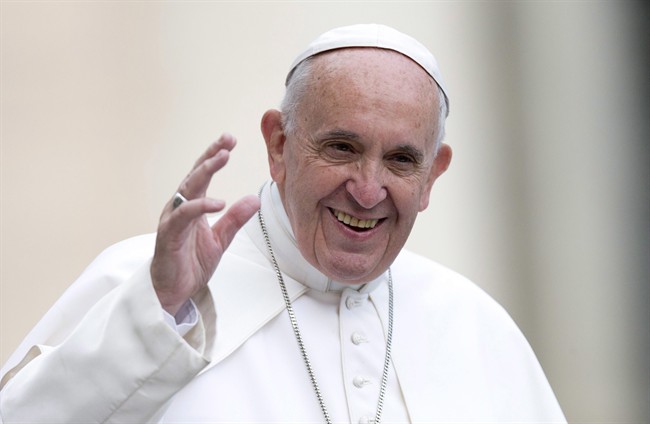YEREVAN, Armenia – The Vatican on Sunday strongly dismissed Turkish claims that Pope Francis has adopted a “Crusades” mentality by recognizing the Ottoman-era genocide of Armenians, insisting that Francis’s three-day visit to the Orthodox country was one of peace and reconciliation.

Francis wrapped up his trip with calls for closer ties with Armenia’s Oriental Orthodox church, a visit near Armenia’s closed western border with Turkey and a joint declaration with the Apostolic Church leader on the plight of Christians in the Mideast. But it was his recognition on Day 1 that the 1915 slaughter by Ottoman Turks of an estimated 1.5 million Armenians constituted planned “genocide” that continued to reverberate.
Turkey issued a harsh rebuttal late Saturday, with Deputy Prime Minister Nurettin Canikli calling the comments untrue, “greatly unfortunate” and saying they bore the hallmarks of the “mentality of the Crusades.”
READ MORE: Denis Coderre says efforts to bring Pope Francis to Montreal next year are going well
Turkey rejects the term genocide, saying the death toll cited by historians is inflated and that people died on both sides as the Ottoman Empire collapsed amid World War I. When Francis first used it last year, Turkey recalled its ambassador for 10 months and accused the pope of spreading lies.
The Vatican spokesman, the Rev. Federico Lombardi, said the Holy See hadn’t received any formal complaint from Turkey as of Sunday. Responding to Canikli’s comments, he said that nothing in Francis’ texts or actions had suggested a Crusades-like mentality or spirit.
“It is a spirit of dialogue, of building peace, of building bridges and not walls,” Lombardi said.
“The pope is not doing Crusades,” he added. “He has said no words against the Turkish people.”
On Sunday, Francis turned his attention to more religious affairs, participating in an open-air liturgy on the grounds of the Armenian Apostolic Cathedral in Etchmiadzin, the seat of the Oriental Orthodox church here. The landlocked nation of 3 million was the first nation in the world to adopt Christianity as a state religion in 301.
Amid haunting chants, Francis processed up and down the central walkway of the Etchmiadzin complex alongside the patriarch, Catholicos Karekin II, both walking under a gold-brocaded canopy as incense furled around them. During the 2-hour service celebrated by Karekin, Francis stood to the side of the altar and offered a greeting calling for greater unity between the two churches.
“May an ardent desire for unity rise up in our hearts, a unity that must not be the submission of one to the other, or assimilation, but rather the acceptance of all the gifts that God has given to each,” he said. “Let us pay heed to the younger generation, who seek a future free of past divisions.”
He then asked Karekin to bless him: “Bless me, bless me and the Catholic Church, and bless this path toward full unity.”
The Armenian Apostolic church and a few other Oriental Orthodox churches split from the Catholic Church in the 5th century in a dispute over the divine and human natures of Jesus Christ. The division arose from the Council of Chalcedon, some six centuries before the Great Schism that split the rest of Orthodoxy from Rome.
While still divided over the primacy of the pope, the Apostolic and Catholic churches have friendly relations and Francis’ visit here has been a visible testimony to their close ties: He and the papal delegation stayed at the Etchmiadzin cathedral complex as guests of Karekin.
That said, there have been tensions: Francis and Karekin were supposed to have signed a joint declaration on their improved ties. In the days leading up to the trip, negotiations stalled and the declaration was taken off the agenda. With a few hours to go until the end of the trip, a text was agreed upon in which the two men expressed their joint concern for Islamic extremist attacks against Christians in the Middle East.
“The martyrs belong to all the churches and their suffering is an ‘ecumenism of blood’ which transcends the historical divisions between Christians, calling us all to promote the visible unity of Christ’s disciples,” the declaration read.
It repeated a line from a 2001 declaration penned by St. John Paul II and Karekin that the slaughter of Armenians was the “first genocide of the 20th century,” and hailed the progress made in warming relations.
After Sunday’s liturgy and a formal luncheon, Francis headed west toward Armenia’s border with Turkey for a visit to a monastery in the shadow of sacred Mt. Ararat.
Turkey closed the frontier in support for its ally and ethnic kin, Azerbaijan, after the Nagorno-Karabakh conflict erupted into a full-scale war in 1992. The blockade has worsened Armenia’s economic problems. Nagorno-Karabakh is officially part of Azerbaijan, but since a separatist war ended in 1994 it has been under the control of forces that claim to be local ethnic Armenians but that Azerbaijan claims include regular Armenian military.
RELATED: Montreal Catholic Church moving towards forbidding priests from being alone with children
Francis has said he would love to see the Turkish-Armenian border reopened, given his longstanding call for countries to build bridges, not walls, at their frontiers.
Francis was due to release a dove of peace near the border at the Khor Virap monastery. The monastery is one of the most sacred sites in Armenia and lies in the shadow of Mt. Ararat, where according to legend, Noah landed his Ark after the great floods.
The final declaration expressed hope that a peaceful resolution would be found to the Nagorno-Karabakh conflict.










Comments